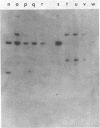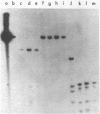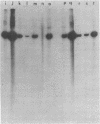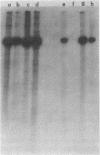Abstract
Juvenile- and adult-onset laryngeal papillomas were examined for the presence of a human papillomavirus (HPV) genome and capsid antigens. DNA was isolated from a portion of tissue removed for therapeutic purposes, and the presence of a papillomavirus genome was detected by Southern transfer analysis. The viral DNA found in the 12 juvenile-onset and the 8 adult-onset laryngeal papillomas examined was identified as HPV-6 on the basis of size, restriction endonuclease digestion patterns, and homology detected under stringent conditions. Restriction endonuclease analysis of the viral genomes revealed at least four different subtypes, designated HPV-6c through HPV-6f. The most common subtype, HPV-6c, was detected in over half of the papillomas studied, including both juvenile and adult types. The remaining tissue was fixed and processed for immunocytochemistry. The immunoperoxidase technique was used with an antiserum that reacts with capsid antigen(s) common to all HPV serotypes. HPV antigen was found in two of the juvenile-onset papillomas and two of the adult-onset papillomas. The antigen was localized to the nucleus and was distributed in the superficial layers of the epithelium. HPV capsid antigen had not previously been detected in cases of adult-onset papilloma, and the HPV genome in both juvenile- and adult-onset laryngeal papillomas had not been characterized. Despite the absence of detectable viral antigen in most of the specimens examined, the presence of the HPV genome provides strong evidence for the papillomavirus etiology of these tumors.
Full text
PDF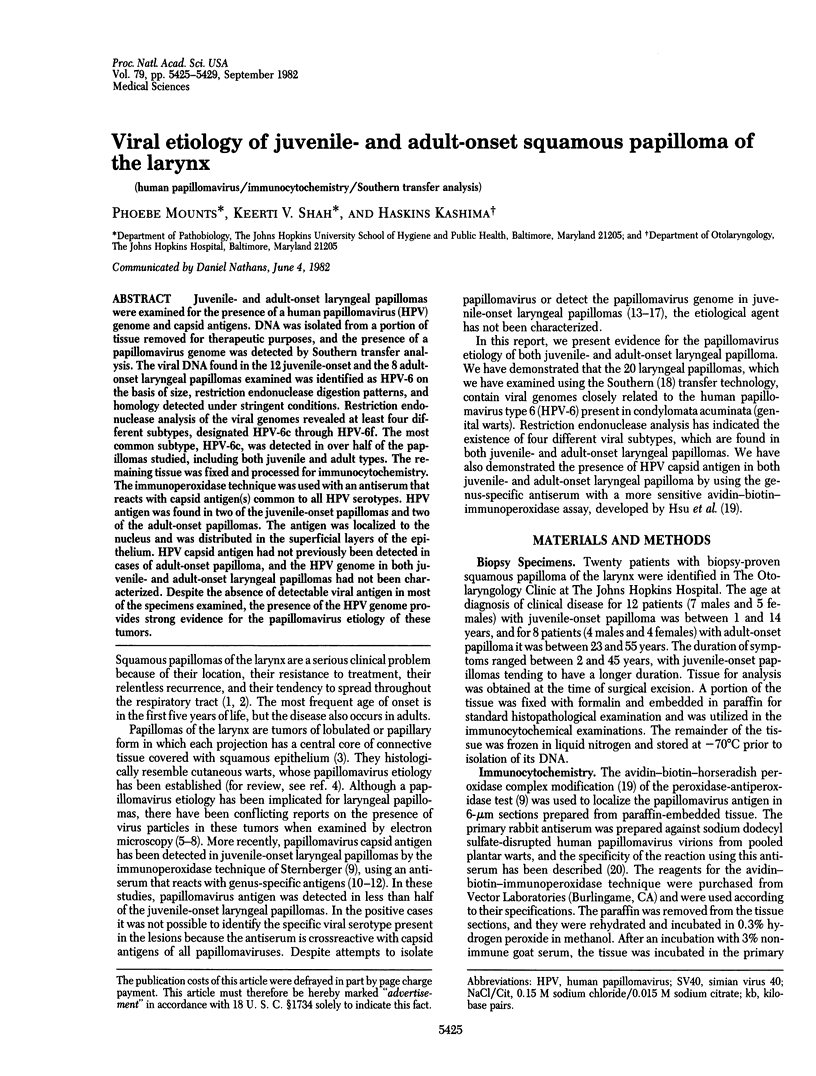




Images in this article
Selected References
These references are in PubMed. This may not be the complete list of references from this article.
- Braun L., Kashima H., Eggleston J., Shah K. Demonstration of papillomavirus antigen in paraffin sections of laryngeal papillomas. Laryngoscope. 1982 Jun;92(6 Pt 1):640–643. doi: 10.1002/lary.1982.92.6.640. [DOI] [PubMed] [Google Scholar]
- CRAWFORD L. V., CRAWFORD E. M. A COMPARATIVE STUDY OF POLYOMA AND PAPILLOMA VIRUSES. Virology. 1963 Oct;21:258–263. doi: 10.1016/0042-6822(63)90265-4. [DOI] [PubMed] [Google Scholar]
- Cook T. A., Brunschwig J. P., Butel J. S., Cohn A. M., Goepfert H., Rawls W. E. Laryngeal papilloma: etiologic and therapeutic considerations. Ann Otol Rhinol Laryngol. 1973 Sep-Oct;82(5):649–655. doi: 10.1177/000348947308200507. [DOI] [PubMed] [Google Scholar]
- Costa J., Howley P. M., Bowling M. C., Howard R., Bauer W. C. Presence of human papilloma viral antigens in juvenile multiple laryngeal papilloma. Am J Clin Pathol. 1981 Feb;75(2):194–197. doi: 10.1093/ajcp/75.2.194. [DOI] [PubMed] [Google Scholar]
- DMOCHOWSKI L., GREY C. E., SYKES J. A., LANGFORD P., JESSE R. H., Jr, MACCOMB, BALLANTYNE A. J., DREYER D. A. ASTUDY OF SUBMICROSCOPIC STRUCTURE AND OF VIRUS PARTICLES IN CELLS OF HUMAN LARYNGEAL PAPILLOMAS. Tex Rep Biol Med. 1964;22:454–491. [PubMed] [Google Scholar]
- Denhardt D. T. A membrane-filter technique for the detection of complementary DNA. Biochem Biophys Res Commun. 1966 Jun 13;23(5):641–646. doi: 10.1016/0006-291x(66)90447-5. [DOI] [PubMed] [Google Scholar]
- Dunn A. R., Sambrook J. Mapping viral mRNAs by sandwich hybridization. Methods Enzymol. 1980;65(1):468–478. doi: 10.1016/s0076-6879(80)65056-3. [DOI] [PubMed] [Google Scholar]
- Gissmann L., Pfister H., Zur Hausen H. Human papilloma viruses (HPV): characterization of four different isolates. Virology. 1977 Feb;76(2):569–580. doi: 10.1016/0042-6822(77)90239-2. [DOI] [PubMed] [Google Scholar]
- Gissmann L., zur Hausen H. Partial characterization of viral DNA from human genital warts (Condylomata acuminata). Int J Cancer. 1980 May 15;25(5):605–609. doi: 10.1002/ijc.2910250509. [DOI] [PubMed] [Google Scholar]
- HAJEK E. F. Contribution to the etiology of laryngeal papilloma in children. J Laryngol Otol. 1956 Mar;70(3):166–168. doi: 10.1017/s0022215100052798. [DOI] [PubMed] [Google Scholar]
- Heilman C. A., Law M. F., Israel M. A., Howley P. M. Cloning of human papilloma virus genomic DNAs and analysis of homologous polynucleotide sequences. J Virol. 1980 Nov;36(2):395–407. doi: 10.1128/jvi.36.2.395-407.1980. [DOI] [PMC free article] [PubMed] [Google Scholar]
- Holinger P. H., Schild J. A., Maurizi D. G. Laryngeal papilloma: review of etiology and therapy. Laryngoscope. 1968 Sep;78(9):1462–1474. doi: 10.1288/00005537-196809000-00003. [DOI] [PubMed] [Google Scholar]
- Hsu S. M., Raine L., Fanger H. Use of avidin-biotin-peroxidase complex (ABC) in immunoperoxidase techniques: a comparison between ABC and unlabeled antibody (PAP) procedures. J Histochem Cytochem. 1981 Apr;29(4):577–580. doi: 10.1177/29.4.6166661. [DOI] [PubMed] [Google Scholar]
- Jeffreys A. J., Flavell R. A. A physical map of the DNA regions flanking the rabbit beta-globin gene. Cell. 1977 Oct;12(2):429–439. doi: 10.1016/0092-8674(77)90119-2. [DOI] [PubMed] [Google Scholar]
- Jenson A. B., Rosenthal J. D., Olson C., Pass F., Lancaster W. D., Shah K. Immunologic relatedness of papillomaviruses from different species. J Natl Cancer Inst. 1980 Mar;64(3):495–500. [PubMed] [Google Scholar]
- Kaufman R. S., Balogh K. Verrucas and juvenile laryngeal papillomas. Arch Otolaryngol. 1969 May;89(5):748–749. doi: 10.1001/archotol.1969.00770020750013. [DOI] [PubMed] [Google Scholar]
- Lack E. E., Jenson A. B., Smith H. G., Healy G. B., Pass F., Vawter G. F. Immunoperoxidase localization of human papillomavirus in laryngeal papillomas. Intervirology. 1980;14(3-4):148–154. doi: 10.1159/000149176. [DOI] [PubMed] [Google Scholar]
- Lancaster W. D., Jenson A. B. Evidence for papillomavirus genus-specific antigens and DNA in laryngeal papilloma. Intervirology. 1981;15(4):204–212. doi: 10.1159/000149233. [DOI] [PubMed] [Google Scholar]
- MAJOROS M., PARKHILL E. M., DEVINE K. D. PAPILLOMA OF THE LARYNX IN CHILDREN. A CLINICOPATHOLOGIC STUDY. Am J Surg. 1964 Oct;108:470–475. doi: 10.1016/0002-9610(64)90138-2. [DOI] [PubMed] [Google Scholar]
- Maniatis T., Jeffrey A., Kleid D. G. Nucleotide sequence of the rightward operator of phage lambda. Proc Natl Acad Sci U S A. 1975 Mar;72(3):1184–1188. doi: 10.1073/pnas.72.3.1184. [DOI] [PMC free article] [PubMed] [Google Scholar]
- McCoy E. G., Boyle W. F., Fogarty W. A. Electron microscopic identification of virus-like particles in laryngeal papilloma. Ann Otol Rhinol Laryngol. 1971 Oct;80(5):693–698. doi: 10.1177/000348947108000511. [DOI] [PubMed] [Google Scholar]
- Morin C., Braun L., Casas-Cordero M., Shah K. V., Roy M., Fortier M., Meisels A. Confirmation of the papillomavirus etiology of condylomatous cervix lesions by the peroxidase-antiperoxidase technique. J Natl Cancer Inst. 1981 May;66(5):831–835. [PubMed] [Google Scholar]
- Quick C. A., Faras A., Krzysek R. The etiology of laryngeal papillomatosis. Laryngoscope. 1978 Nov;88(11):1789–1795. doi: 10.1288/00005537-197811000-00009. [DOI] [PubMed] [Google Scholar]
- Quick C. A., Watts S. L., Krzyzek R. A., Faras A. J. Relationship between condylomata and laryngeal papillomata. Clinical and molecular virological evidence. Ann Otol Rhinol Laryngol. 1980 Sep-Oct;89(5 Pt 1):467–471. doi: 10.1177/000348948008900521. [DOI] [PubMed] [Google Scholar]
- Rigby P. W., Dieckmann M., Rhodes C., Berg P. Labeling deoxyribonucleic acid to high specific activity in vitro by nick translation with DNA polymerase I. J Mol Biol. 1977 Jun 15;113(1):237–251. doi: 10.1016/0022-2836(77)90052-3. [DOI] [PubMed] [Google Scholar]
- Rowson K. E., Mahy B. W. Human papova (wart) virus. Bacteriol Rev. 1967 Jun;31(2):110–131. doi: 10.1128/br.31.2.110-131.1967. [DOI] [PMC free article] [PubMed] [Google Scholar]
- SVOBODA D. J., KIRCHNER F. R., PROUD G. O. ELECTRON MICROSCOPIC STUDY OF HUMAN LARYNGEAL PAPILLOMATOSIS. Cancer Res. 1963 Aug;23:1084–1089. [PubMed] [Google Scholar]
- Southern E. M. Detection of specific sequences among DNA fragments separated by gel electrophoresis. J Mol Biol. 1975 Nov 5;98(3):503–517. doi: 10.1016/s0022-2836(75)80083-0. [DOI] [PubMed] [Google Scholar]
- de Villiers E. M., Gissmann L., zur Hausen H. Molecular cloning of viral DNA from human genital warts. J Virol. 1981 Dec;40(3):932–935. doi: 10.1128/jvi.40.3.932-935.1981. [DOI] [PMC free article] [PubMed] [Google Scholar]
- zur Hausen H., Meinhof W., Scheiber W., Bornkamm G. W. Attempts to detect virus-secific DNA in human tumors. I. Nucleic acid hybridizations with complementary RNA of human wart virus. Int J Cancer. 1974 May 15;13(5):650–656. doi: 10.1002/ijc.2910130509. [DOI] [PubMed] [Google Scholar]





